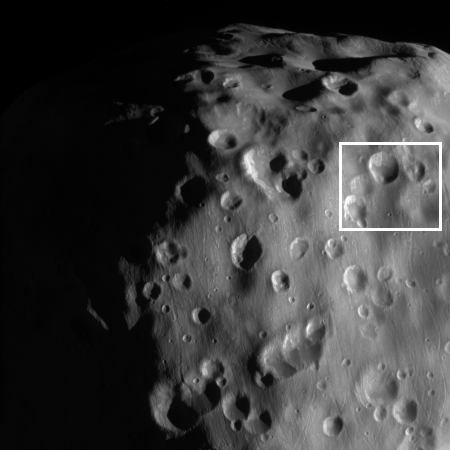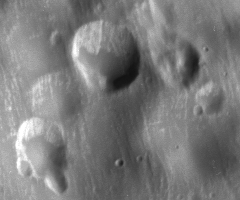The soft craters of Epimetheus

Cool image time! The image on the right, reduced in resolution to show here, is the highest resolution image that Cassini has taken of the Saturn moon Epimetheus, taken from only 9,300 miles away on February 21, 2017.
Epimetheus (70 miles or 113 kilometers across) is too small for its gravity to hold onto an atmosphere. It is also too small to be geologically active. There is therefore no way to erase the scars from meteor impacts, except for the generation of new impact craters on top of old ones.
Below is the inset at full resolution, showing several craters, with ponds of dust on their floor. Overall, the surface of this tiny moon looks soft. The craters are all shallow, as if any impact merely plunged into a blob of ice cream. Any ejecta from those impacts eventually rained back down, and then settled slowly in the moon’s low points, forming those ponds of dust.

In many ways this image is very revealing, as it shows what the early accretion process of any planetary body will look like. Nor is this unique. Earlier images taken of the asteroid Eros by the NEAR probe saw many of these same features, as have images of Saturn’s other small moons. In the early stages, new material gets absorbed easily because it finds it easy to bore into the body of the newly formed and not very dense planetary body. There isn’t much ejecta, and what there is doesn’t fly that far away so that it can settle back down on the surface and add to the new body’s total mass.
On Christmas Eve 1968 three Americans became the first humans to visit another world. What they did to celebrate was unexpected and profound, and will be remembered throughout all human history. Genesis: the Story of Apollo 8, Robert Zimmerman's classic history of humanity's first journey to another world, tells that story, and it is now available as both an ebook and an audiobook, both with a foreword by Valerie Anders and a new introduction by Robert Zimmerman.
The print edition can be purchased at Amazon or from any other book seller. If you want an autographed copy the price is $60 for the hardback and $45 for the paperback, plus $8 shipping for each. Go here for purchasing details. The ebook is available everywhere for $5.99 (before discount) at amazon, or direct from my ebook publisher, ebookit. If you buy it from ebookit you don't support the big tech companies and the author gets a bigger cut much sooner.
The audiobook is also available at all these vendors, and is also free with a 30-day trial membership to Audible.
"Not simply about one mission, [Genesis] is also the history of America's quest for the moon... Zimmerman has done a masterful job of tying disparate events together into a solid account of one of America's greatest human triumphs."--San Antonio Express-News

Cool image time! The image on the right, reduced in resolution to show here, is the highest resolution image that Cassini has taken of the Saturn moon Epimetheus, taken from only 9,300 miles away on February 21, 2017.
Epimetheus (70 miles or 113 kilometers across) is too small for its gravity to hold onto an atmosphere. It is also too small to be geologically active. There is therefore no way to erase the scars from meteor impacts, except for the generation of new impact craters on top of old ones.
Below is the inset at full resolution, showing several craters, with ponds of dust on their floor. Overall, the surface of this tiny moon looks soft. The craters are all shallow, as if any impact merely plunged into a blob of ice cream. Any ejecta from those impacts eventually rained back down, and then settled slowly in the moon’s low points, forming those ponds of dust.

In many ways this image is very revealing, as it shows what the early accretion process of any planetary body will look like. Nor is this unique. Earlier images taken of the asteroid Eros by the NEAR probe saw many of these same features, as have images of Saturn’s other small moons. In the early stages, new material gets absorbed easily because it finds it easy to bore into the body of the newly formed and not very dense planetary body. There isn’t much ejecta, and what there is doesn’t fly that far away so that it can settle back down on the surface and add to the new body’s total mass.
On Christmas Eve 1968 three Americans became the first humans to visit another world. What they did to celebrate was unexpected and profound, and will be remembered throughout all human history. Genesis: the Story of Apollo 8, Robert Zimmerman's classic history of humanity's first journey to another world, tells that story, and it is now available as both an ebook and an audiobook, both with a foreword by Valerie Anders and a new introduction by Robert Zimmerman.
The print edition can be purchased at Amazon or from any other book seller. If you want an autographed copy the price is $60 for the hardback and $45 for the paperback, plus $8 shipping for each. Go here for purchasing details. The ebook is available everywhere for $5.99 (before discount) at amazon, or direct from my ebook publisher, ebookit. If you buy it from ebookit you don't support the big tech companies and the author gets a bigger cut much sooner.
The audiobook is also available at all these vendors, and is also free with a 30-day trial membership to Audible.
"Not simply about one mission, [Genesis] is also the history of America's quest for the moon... Zimmerman has done a masterful job of tying disparate events together into a solid account of one of America's greatest human triumphs."--San Antonio Express-News


Of course, It could be just a big ball of dust. I would imagine that any body orbiting Saturn would have a high dust content. After millions of years of slow speed impacts (like sand on the beach) I would imagine the majority of the particles in the rings are microscopic.
My favorite moon is Hyperion of Saturn. What the heck happened there? The tallest craters in the Solar system. And exactly all of it has been hit by impactors that created the same size craters. It’s one of the moons that has chaotic rotation. There are dust balls and scum bags orbiting around there, and there are other stuffs too. Amazing all of it.
https://solarsystem.nasa.gov/planets/hyperion